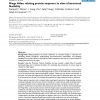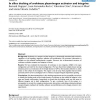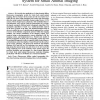796 search results - page 75 / 160 » Molecular Surface Abstraction |
BMCBI
2007
13 years 10 months ago
2007
Background: Relating features of protein sequences to structural hinges is important for identifying domain boundaries, understanding structure-function relationships, and designi...
BMCBI
2008
13 years 10 months ago
2008
Background: Urokinase, its receptor and the integrins are functionally associated and involved in regulation of cell signaling, migration, adhesion and proliferation. No structura...
BMCBI
2006
13 years 10 months ago
2006
Background: Bacterial typing schemes based on the sequences of genes encoding surface antigens require databases that provide a uniform, curated, and widely accepted nomenclature ...
TMI
2008
13 years 9 months ago
2008
We describe the application of a time domain diffuse fluorescence tomography system for whole body small animal imaging. The key features of the system are the use of point excitat...
ICCV
2003
IEEE
14 years 11 months ago
2003
IEEE
Most of the work on 3-D object recognition from range data has used an alignment-verification approach in which a specific 3-D object is matched to an exact instance of the same o...



